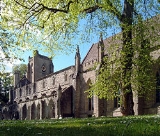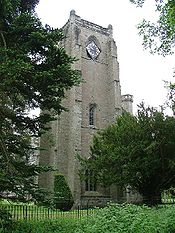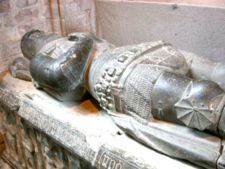
Dunkeld Cathedral
Encyclopedia
Dunkeld Cathedral stands on the north bank of the River Tay
in Dunkeld
, Perth and Kinross
, Scotland
. Built in square-stone style of predominantly grey sandstone, the cathedral proper was begun in 1260 and completed in 1501. It stands on the site of the former Culdee
Monastery of Dunkeld, stones from which can be seen as an irregular reddish streak in the eastern gable.
 Because of the long construction period, the cathedral shows mixed architecture
Because of the long construction period, the cathedral shows mixed architecture
. Gothic
and Norman
elements are intermingled throughout the structure. Although partly in ruins, the cathedral is in regular use today and is open to the public. The small Chapter House Museum offers a collection of relics from monastic and Medieval times, and local history exhibits.
Relics of Saint Columba
, including his bones, were said to have been kept at Dunkeld until the Reformation
, at which time they were removed to Ireland
. Some believe there are still undiscovered Columban relics buried within the cathedral grounds.
The original monastery at Dunkeld dated from the sixth or early seventh century, founded after an expedition of Saint Columba to the Land of Alba
. It was at first a simple collection of wattle huts. During the ninth century Caustantín mac Fergusa
constructed a more substantial monastery of reddish sandstone and declared Dunkeld the Primacy (centre) of the faith in Alba.
For reasons not completely understood, the Celt
ic bell believed to have been used at the monastery is not preserved in the cathedral. Instead, it was used in the Little Dunkeld Church, the parish church of the district of Minor or Lesser Dunkeld. Possibly this was because the later Augustinian Canon
s regarded Culdeeism as heresy
, and refused relics or saints of that faith.
In the 11th century, the Celtic Abbacy of Dunkeld became an appanage of the Crown and subsequently descended to the Earls of Fife
. Dunkeld Cathedral is today a Crown
Property, through Historic Scotland
.
 Alexander Stewart, Earl of Buchan, known as "the Wolf of Badenoch", was buried in the cathedral following his death in 1405, where his tomb, surmounted by his armoured effigy
Alexander Stewart, Earl of Buchan, known as "the Wolf of Badenoch", was buried in the cathedral following his death in 1405, where his tomb, surmounted by his armoured effigy
, can still be seen.
In 1689 the Battle of Dunkeld
was fought around the cathedral between the Jacobite
Highlanders
loyal to James II and VII and a government force supporting William of Orange
, with the latter winning the day.
Dunkeld Cathedral is still used as the town's Church of Scotland
parish church, with services every Sunday (although the congregation uses the smaller "Little Dunkeld" Church during winter months.) The current minister (since 2001) is the Reverend R. Fraser Penny.
River Tay
The River Tay is the longest river in Scotland and the seventh-longest in the United Kingdom. The Tay originates in western Scotland on the slopes of Ben Lui , then flows easterly across the Highlands, through Loch Dochhart, Loch Lubhair and Loch Tay, then continues east through Strathtay , in...
in Dunkeld
Dunkeld
Dunkeld is a small town in Strathtay, Perth and Kinross, Scotland. It is about 15 miles north of Perth on the eastern side of the A9 road into the Scottish Highlands and on the opposite side of the Tay from the Victorian village of Birnam. Dunkeld and Birnam share a railway station, on the...
, Perth and Kinross
Perth and Kinross
Perth and Kinross is one of 32 council areas in Scotland, and a Lieutenancy Area. It borders onto the Aberdeenshire, Angus, Dundee City, Fife, Clackmannanshire, Stirling, Argyll and Bute and Highland council areas. Perth is the administrative centre...
, Scotland
Scotland
Scotland is a country that is part of the United Kingdom. Occupying the northern third of the island of Great Britain, it shares a border with England to the south and is bounded by the North Sea to the east, the Atlantic Ocean to the north and west, and the North Channel and Irish Sea to the...
. Built in square-stone style of predominantly grey sandstone, the cathedral proper was begun in 1260 and completed in 1501. It stands on the site of the former Culdee
Culdee
Céli Dé or Culdees were originally members of ascetic Christian monastic and eremitical communities of Ireland, Scotland and England in the Middle Ages. The term is used of St. John the Apostle, of a missioner from abroad recorded in the Annals of the Four Masters at the year 806, and of Óengus...
Monastery of Dunkeld, stones from which can be seen as an irregular reddish streak in the eastern gable.

Architecture
Architecture is both the process and product of planning, designing and construction. Architectural works, in the material form of buildings, are often perceived as cultural and political symbols and as works of art...
. Gothic
Gothic architecture
Gothic architecture is a style of architecture that flourished during the high and late medieval period. It evolved from Romanesque architecture and was succeeded by Renaissance architecture....
and Norman
Norman architecture
About|Romanesque architecture, primarily English|other buildings in Normandy|Architecture of Normandy.File:Durham Cathedral. Nave by James Valentine c.1890.jpg|thumb|200px|The nave of Durham Cathedral demonstrates the characteristic round arched style, though use of shallow pointed arches above the...
elements are intermingled throughout the structure. Although partly in ruins, the cathedral is in regular use today and is open to the public. The small Chapter House Museum offers a collection of relics from monastic and Medieval times, and local history exhibits.
Relics of Saint Columba
Saint Columba
-Saints:* Columba , Irish Christian saint who evangelized Scotland* Columba the Virgin, also known as Saint Columba of Cornwall* Columba of Sens* Columba of Spain* Columba of Terryglass* Sancta Columba -Schools:...
, including his bones, were said to have been kept at Dunkeld until the Reformation
Scottish Reformation
The Scottish Reformation was Scotland's formal break with the Papacy in 1560, and the events surrounding this. It was part of the wider European Protestant Reformation; and in Scotland's case culminated ecclesiastically in the re-establishment of the church along Reformed lines, and politically in...
, at which time they were removed to Ireland
Ireland
Ireland is an island to the northwest of continental Europe. It is the third-largest island in Europe and the twentieth-largest island on Earth...
. Some believe there are still undiscovered Columban relics buried within the cathedral grounds.
The original monastery at Dunkeld dated from the sixth or early seventh century, founded after an expedition of Saint Columba to the Land of Alba
Alba
Alba is the Scottish Gaelic name for Scotland. It is cognate to Alba in Irish and Nalbin in Manx, the two other Goidelic Insular Celtic languages, as well as similar words in the Brythonic Insular Celtic languages of Cornish and Welsh also meaning Scotland.- Etymology :The term first appears in...
. It was at first a simple collection of wattle huts. During the ninth century Caustantín mac Fergusa
Caustantín of the Picts
Causantín or Constantín mac Fergusa was king of the Picts , in modern Scotland, from 789 until 820. He was until the Victorian era sometimes counted as Constantine I of Scotland; the title is now generally given to Causantín mac Cináeda...
constructed a more substantial monastery of reddish sandstone and declared Dunkeld the Primacy (centre) of the faith in Alba.
For reasons not completely understood, the Celt
Celt
The Celts were a diverse group of tribal societies in Iron Age and Roman-era Europe who spoke Celtic languages.The earliest archaeological culture commonly accepted as Celtic, or rather Proto-Celtic, was the central European Hallstatt culture , named for the rich grave finds in Hallstatt, Austria....
ic bell believed to have been used at the monastery is not preserved in the cathedral. Instead, it was used in the Little Dunkeld Church, the parish church of the district of Minor or Lesser Dunkeld. Possibly this was because the later Augustinian Canon
Canon (priest)
A canon is a priest or minister who is a member of certain bodies of the Christian clergy subject to an ecclesiastical rule ....
s regarded Culdeeism as heresy
Heresy
Heresy is a controversial or novel change to a system of beliefs, especially a religion, that conflicts with established dogma. It is distinct from apostasy, which is the formal denunciation of one's religion, principles or cause, and blasphemy, which is irreverence toward religion...
, and refused relics or saints of that faith.
In the 11th century, the Celtic Abbacy of Dunkeld became an appanage of the Crown and subsequently descended to the Earls of Fife
Earl of Fife
The Earl of Fife or Mormaer of Fife referred to the Gaelic comital lordship of Fife which existed in Scotland until the early 15th century....
. Dunkeld Cathedral is today a Crown
The Crown
The Crown is a corporation sole that in the Commonwealth realms and any provincial or state sub-divisions thereof represents the legal embodiment of governance, whether executive, legislative, or judicial...
Property, through Historic Scotland
Historic Scotland
Historic Scotland is an executive agency of the Scottish Government, responsible for historic monuments in Scotland.-Role:As its website states:...
.

Effigy
An effigy is a representation of a person, especially in the form of sculpture or some other three-dimensional form.The term is usually associated with full-length figures of a deceased person depicted in stone or wood on church monuments. These most often lie supine with hands together in prayer,...
, can still be seen.
In 1689 the Battle of Dunkeld
Battle of Dunkeld
The Battle of Dunkeld was fought between Jacobite clans supporting the deposed king James VII of Scotland and a government regiment of covenanters supporting William of Orange, King of Scotland, in the streets around Dunkeld Cathedral, Dunkeld, Scotland, on 21 August 1689 and formed part of the...
was fought around the cathedral between the Jacobite
Jacobitism
Jacobitism was the political movement in Britain dedicated to the restoration of the Stuart kings to the thrones of England, Scotland, later the Kingdom of Great Britain, and the Kingdom of Ireland...
Highlanders
Scottish Highlands
The Highlands is an historic region of Scotland. The area is sometimes referred to as the "Scottish Highlands". It was culturally distinguishable from the Lowlands from the later Middle Ages into the modern period, when Lowland Scots replaced Scottish Gaelic throughout most of the Lowlands...
loyal to James II and VII and a government force supporting William of Orange
William III of England
William III & II was a sovereign Prince of Orange of the House of Orange-Nassau by birth. From 1672 he governed as Stadtholder William III of Orange over Holland, Zeeland, Utrecht, Guelders, and Overijssel of the Dutch Republic. From 1689 he reigned as William III over England and Ireland...
, with the latter winning the day.
Dunkeld Cathedral is still used as the town's Church of Scotland
Church of Scotland
The Church of Scotland, known informally by its Scots language name, the Kirk, is a Presbyterian church, decisively shaped by the Scottish Reformation....
parish church, with services every Sunday (although the congregation uses the smaller "Little Dunkeld" Church during winter months.) The current minister (since 2001) is the Reverend R. Fraser Penny.
Other burials
- John Scotus (Bishop of Dunkeld), (1183–1203)
- Geoffrey de Liberatione, Bishop of Dunkeld (1236/7–1249)
- Richard de InverkeithingRichard de InverkeithingRichard de Inverkeithing was a 13th century cleric from Scotland, probably from Inverkeithing in Fife. He was a Chamberlain of King Alexander II of Scotland and bishop of Dunkeld....
, a ChamberlainChamberlain (office)A chamberlain is an officer in charge of managing a household. In many countries there are ceremonial posts associated with the household of the sovereign....
of King Alexander II of ScotlandAlexander II of ScotlandAlexander II was King of Scots from1214 to his death.-Early life:...
and Bishop of Dunkeld (1250/2–1272) - William Sinclair (bishop), Bishop of Dunkeld (1309–1337)
- Michael de MonymuskMichael de MonymuskMichael de Monymusk was a 14th century bishop of Dunkeld. He held a licentiate in Canon law. He had been dean of the bishopric of Dunblane, dean of the bishopric of Aberdeen, and then dean of the bishopric of Glasgow...
, Bishop of Dunkeld (1370–1376) - Robert CockburnRobert CockburnRobert Cockburn was a 16th century Scottish diplomat and cleric. Cockburn was a university graduate, and appears for the first time in 1501 when he was presented to James IV of Scotland for the position of parson of Dunbar, being styled "Master Robert Cockburn, dean of Rouen"...
, Bishop of Dunkeld (1524–1526) - Charles Edward Stuart, Count RoehenstartCharles Edward Stuart, Count RoehenstartCharles Edward Augustus Maximilian Stuart, Baron Korff, Count Roehenstart was the natural son of Prince Ferdinand of Rohan , Roman Catholic Archbishop of Cambrai, by Charlotte Stuart, Duchess of Albany, herself the natural but legitimated daughter of Charles Edward Stuart, the Young Pretender...
(1784–1854)

